unit 5 market structures
1/74
There's no tags or description
Looks like no tags are added yet.
Name | Mastery | Learn | Test | Matching | Spaced |
|---|
No study sessions yet.
75 Terms
allocative efficiency
where recourses follow consumer demand, where society surplus is maximised, where net social benefit is maximised
AR/P = MC
MSB = MSC
consumer benefit
resources follow consumer demand
low prices
maximisation of consumer surplus
high choice
high quality
producer benefit
retained/increased MS
more competitive
increased profit
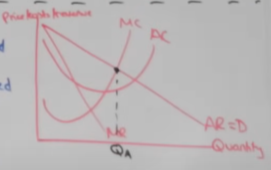
productive efficiency
firm operating at the lowest point on AC curve - minimising costs, maximisation of output at the lowest AC
fully exploiting EOS
MC = AC
consumer benefit
lower prices
higher consumer surplus
producer benefit
more production at lower cost - greater profit
lower prices - more competitive - greater MS
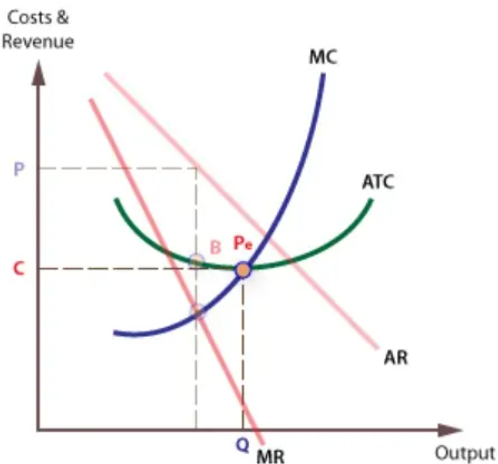
X efficiency
minimising waste, producing on AC curve
consumer benefit
lower prices - higher consumer surplus
producer benefit
lower costs
higher profit
more competitive, higher MS
X inefficiency = producing above AC curve
why
monopolist - no competition
public sector - not profit motivated, they maximise social welfare
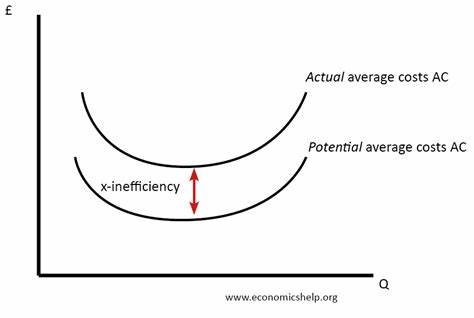
dynamic efficiency
reinvestment of long run supernormal profit back into the business in the form of better capital, R And D , innovation, new technology
MR = MC (supernormal profit in the long run)
consumer benefit
new products
lower prices over time because of new technology, production techniques more competition
high consumer surplus
producer benefit
long run profit maximisation
more competitive - price maker ability
lower costs over time
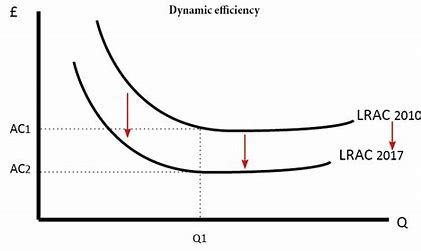
static efficiency
consist of these efficiency as they all occur at a specific production point, where as dynamic efficiency occurs over time
allocative efficiency
productive efficiency
X efficiency
profit maximisation - objective of firms
MR= MC - no more extra profit can be made
why
reinvestment - innovation - lower costs
dividends for shareholders
lower costs and lower prices for consumers
why do some firms not profit maximise
don’t know MR/MC
avoid regulation/investigation
key stakeholders harmed - consumers, workers, government - environmental groups (anyone with interest in business)
other objectives
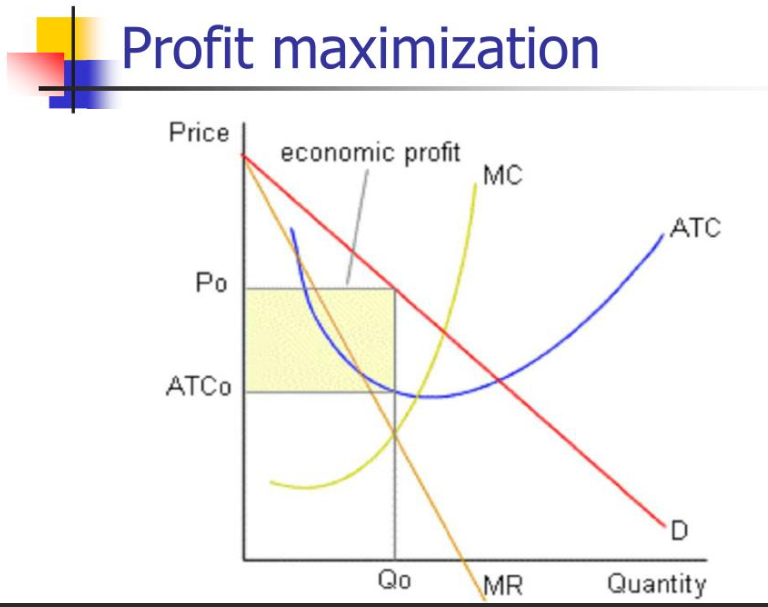
profit satisficing - objective of firms
anywhere between profit max and sales mx
a firm sacrifices profit to satisfy as many key stakeholders as possible
harming workers could cause a strike
harming consumers could create bad publicity
harming government could investigate
revenue maximisation - objective of firms
MR = 0
why
EOS benefits - higher quantity than profit max
predatory pricing - lower than profit max price
principle agent problem - divorce between ownership and control
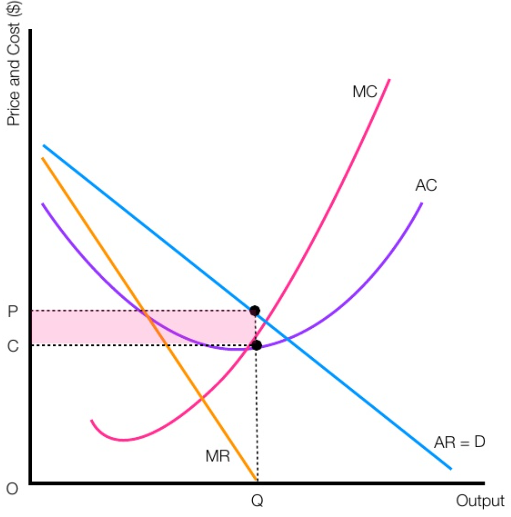
predatory pricing
pricing strategy where a firm sets prices low, sacrificing profit with the intent to eliminate competition and gain market power
divorce between ownership and control
a situation in which the owners of a firm (shareholders) are different from the managers (agents) who run the company, potentially leading to conflicts of interest
owners want profit maximisation
managers want to revenue maximise to inflate bonuses
sales maximisation - objective of firms
growth maximisation
AC = AR
why
EOS - higher output
limit pricing - normal profit - no incentive for firms to enter market
principle agent problem - divorce between ownership an control
flood the market - increase brand loyalty
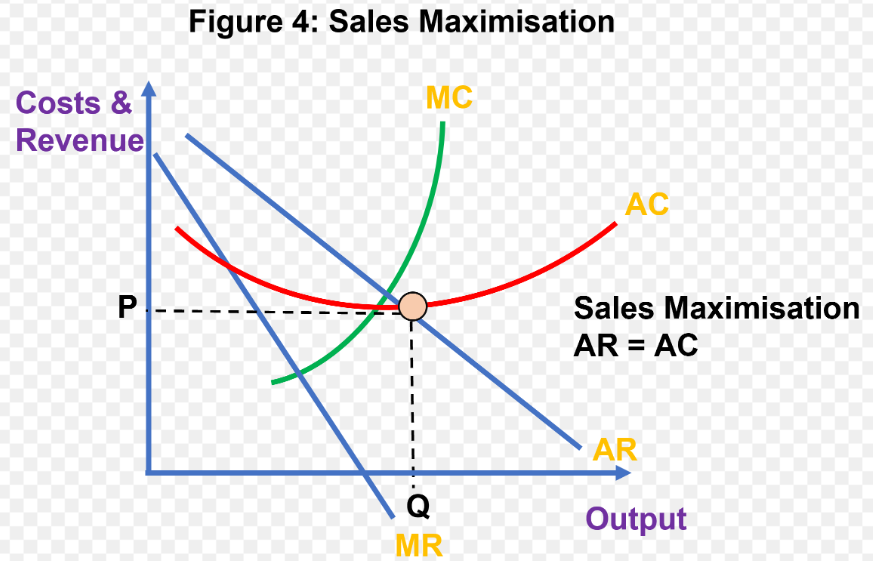
other objectives of firms
survival - short term to enter a competitive market
public sector organisation
P = MC, allocative efficiency
maximise society welfare
corporate social responsibility
charity, sustainability, ethical
shutdown condition in perfect competition
a business needs to make at least normal profit in the long run to justify remaining in an industry
a firm will choose to operate if AR covers AVC, if AR falls below this level, the firm should shut down to minimize losses
shutdown condition = AR =< AVC
this loss can no be sustained so it makes since for the firm to leave the industry and move FOP elsewhere
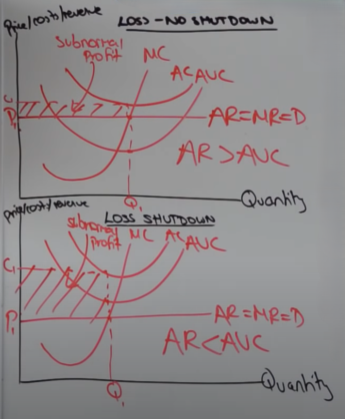
process innovation
changes in the way in which production takes place or is organised
product innovation
small scale and frequent subtle changes to the characteristics and performance of a good or service
perfect competition characteristics
no barriers to entry / exit
many buyers and sellers
homogenous goods
price takers
perfect information
firms are profit maximisers
perfect competition in the short run
price is determined by the market as firms are price takers (S = D)
supernormal profit is made as AC is below AR
profit is greater than costs
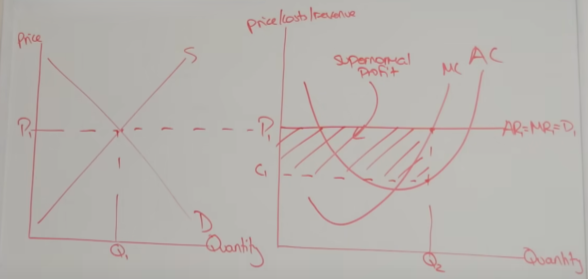
perfect competition in the long run
the supernormal profit made in the short run attracts new entrants into the market (signal), and due to no barriers to entry and perfect information they can enter easily
as these new firms enter the market, the market supply shifts to the right, lowering the price from P1 to P2
firms take this new price as they are price takers meaning that now AR = AC reducing supernormal profit down to normal profit
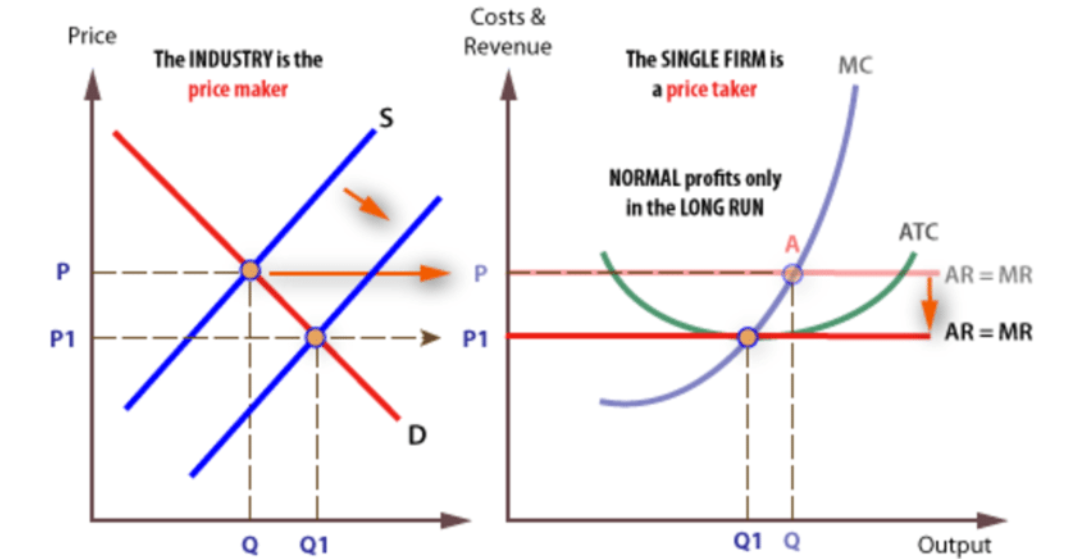
perfect competition evaluation
is allocatively efficient as AR/P = MC
highest consumer surplus
resources perfectly following consumer demand
is productively efficient, operating at lowest point on AC curve (MC = AC)
is X efficient as they are producing on the AC curve
is statically efficient
not dynamically efficient in the long run as there is no supernormal profit to reinvest
characteristics of monopolistic competition
many buyers and sellers
each firm selling slightly differentiated goods
price makers slightly
because of substitutes
so price elastic demand curves
low barriers to entry / exit
good information
non-price completion as firms cant raise price too much
firms are profit maximisers
example - clothing market, restaurants
monopolistic competition in the short run
firms are able to make supernormal profit in the short run as they exploit their price making power as they are selling a unique good
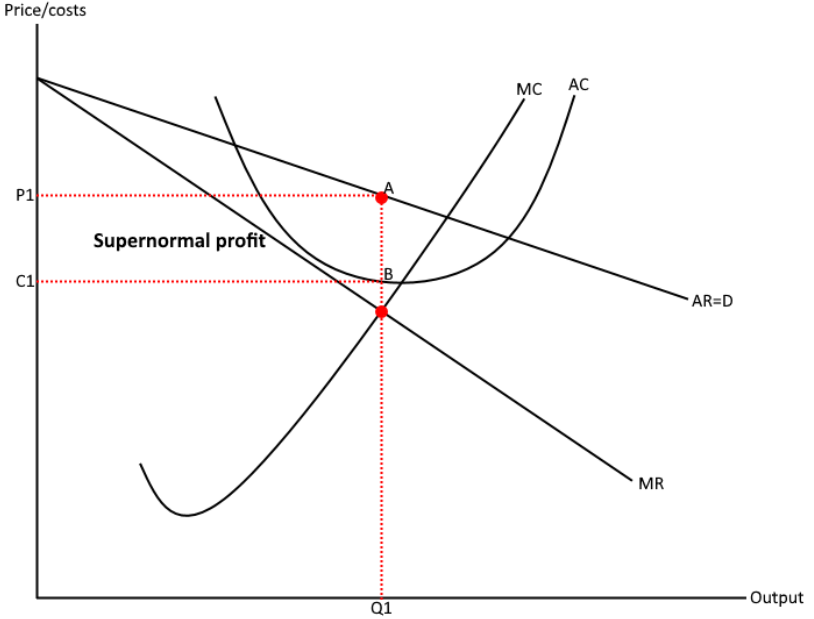
monopolistic competition in the long run
in the long run firms enter the market as they are attracted to the supernormal profit (signal), they can do do as there are low barriers to entry and good information of market conditions
this erodes away the supernormal profit made in the short run as new firms compete with established firms
as new firms enter the market, demand for individual firms shifts left as consumers are shared across a larger number of new firms, consumers buy substitutes from new firms, while AC doesn’t move
demand now = AC and normal profit is made
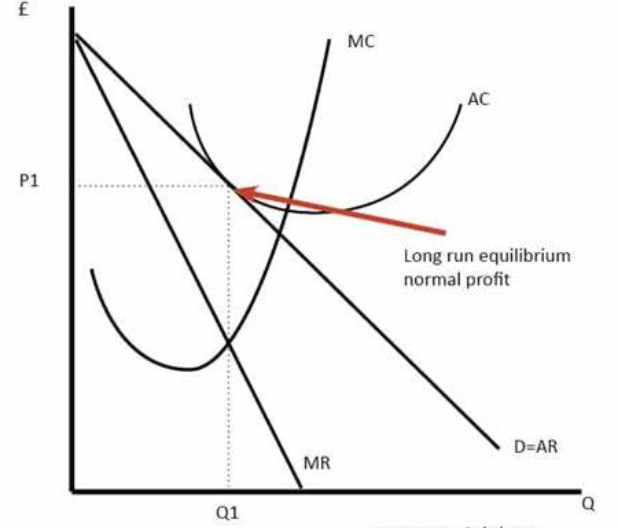
monopolistic competition evaluation
allocatively inefficient in the long run as price doesn’t equal MR, price is greater that MC, consumers are exploited, restricted output, less choice
however not as bad as a monopoly as firms don’t have as much price setting ability as there is lots of competition, loss of consumer surplus isn’t as bad as a monopoly
compered to perfect competition, allocative inefficiency can be considered desirable as there are not homogenous goods, consumers are willing to pay more and erode a bit of their consumer surplus for that
productively inefficient - voluntarily forgoing EOS and costs are not being minimised, producing a range of products makes it harder to achieve purchasing and technical EOS
more EOS than in perfect competition, so prices may be lower
productive inefficiency may be due to the product differentiation demand of consumers
not dynamically efficient as there is no long run supernormal profit being made - cant be reinvested
however if short run supernormal profit is enough to reinvest we see dynamic efficiency
characteristics of an oligopoly
few firms dominate the market
high concentration ratio
differentiated goods
firms are price makers
high barriers to entry / exit
interdependence - firms don’t make decisions on their own - they make them off of actions/reactions of rival firms
price rigidity
non-price competition
profit maximisation is not the sole objective
examples of non-price competition
product differentiation
branding
advertising
quality of product / service
example - UK supermarket industry
oligopoly kinked demand curve
firms don’t want to change their price - price rigidity
above P1 demand is price elastic
below P1 demand is inelastic
if a firms raises their price above P1, QD falls proportionality more that the increase in price
why, interdependence, other firms want to gain MS so keep their price at P1 and undercut this firm
so the firm that raised their price suffers and MS and total revenue decreases
if a firm reduces price, demand increases proportionally less than the decrease in price as PED is inelastic
other firms follow the price decrease to retain MS and possibly get into a price war
total revenue falls and overtime there will be no change in MS
as long as costs change within the vertical part of MR and the firm is a profit maximises (producing where MC = MR), they are going to be charging P1
as long as quantity is Q1, price is P1
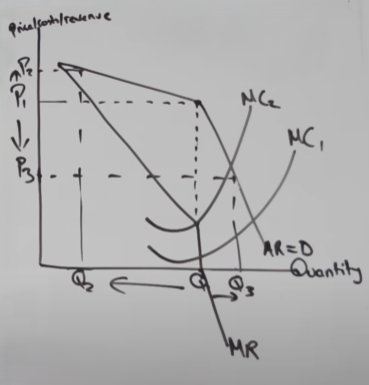
oligopoly evalutation
could be price competition in order to gain MS (price war)
lots of non-price competition as prices stay rigid at P1, to attract consumers
temptation to collude allows firms to act like a monopoly, fix prices and make supernormal profit
concentration ratio
A measure of the market share held by the largest firms in an industry, indicating the level of competition
used to assess market power
CR4 = combined market share (sales) of the 4 largest firms
predatory pricing
focuses on eliminating existing competitors
prices are deliberately and temporarily set very low to restrict competition
P < AVC, shutdown point
illegal
limit pricing
preventing potential competitors from entering market
incumbent firms set price at AR = AC removing supernormal profit to remove the incentive for new firms to enter the market
collusion
anti-competitive agreement between rivals that attempts to disrupt the markets equilibrium
occurs when firms collaborate to set prices or output levels in order to maximize joint profits and reduce competition
illegal
cartel
group of firms that decide to cooperate and collude with each other
illegal
factors promoting a competitive oligopoly
large number of firms - harder to organise collusions
new market entry is possible - making high profit from collusion incentivises entry to the market, taking away supernormal profit
one firm with significant cost advantages - makes it hard to fix prices or quantity
homogenous goods - firms don’t have price making power
saturated market - only way to get ahead of firms is to take MS, high incentive to cheat on collusion
factors promoting a collusive oligopoly
small number of firms - easier to organise collusive agreements
similar costs - easy to fix prices and quantity
high entry barriers - the supernormal profits being made from collusion wont attract new entrants
ineffective competition policy - easier to get away with it
consumer loyalty - firms wont cheat on collusion if other firms have loyal customers
consumer inertia - consumers aren’t willing to switch suppliers
competitive oligopoly evaluation
allocative efficiency
X efficiency
productive efficiency
however no dynamic efficiency or EOS
collusive oligopoly evaluation
dynamic efficiency - supernormal profit - profit max point
not allocatively efficient
not productively efficient
not X efficient
EOS benefits
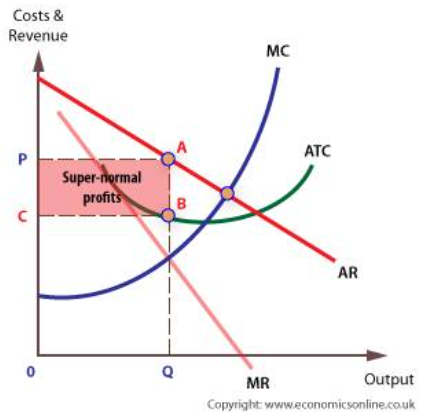
overt collusion
open and formal agreements, is when cartels formally arrange to collude with each other
tacit collusion
competitors coordinate their actions without explicitly agreeing to do so
more difficult for the CMA to prove
price leadership - firms copy the behaviour off the leading (dominant) oligopolist
price fixing in an oligopoly diagram
in the industry firms are profit maximising producing where MC =MR, resulting in P1, Q1
P1 take P1 as they are price takers
the cartel member accepts the output quota other the price charged by the cartel will be distorted
the results in supernormal profit for the cartel
is a cartel cheats (incentive) and exceeds the quota, they will earn excessive supernormal profit, producing at the cheating quantity - P1 still covers AC
however cheating cartel quantity = oversupply, threatening the stability of the cartel
for the cartel to be success is for every member to keep price at P1
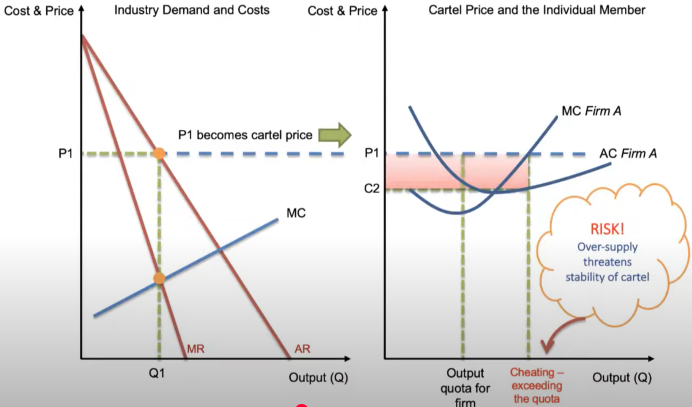
example of anti competitive behavior
in 2015 apple was fined 450 for conspiring with 5 publishers to increase e-book prices
real world advantages of oligopolies
price stability - firms often avoid price wars, leading to more stable prices for consumers
economies of scale - large firms can produce goods more efficiently, reducing costs and potentially lowering prices.
innovation and r&d - competition among few large firms can drive significant investment in research, leading to better products and services
consumer choice - despite few firms, product differentiation (e.g., branding, features) can offer consumers various options
real world disadvantages of oligopolies
collusion risk - firms might collude (tacitly or overtly), fixing prices or output, which harms consumers
restricted competition - new firms face high barriers to entry, reducing market dynamism and innovation over time
higher prices - lack of genuine competition can keep prices artificially high compared to more competitive markets
inefficiency - without competitive pressure, firms may become complacent, leading to productive and allocative inefficiency
manipulative marketing - heavy focus on advertising and brand loyalty can lead consumers to make irrational decisions
issues with cartel
enforcement problems - each firm finds it profitable to raise its own production - difficult for the cartel to enforce output quotas
successful entry of a non-cartel firm - undercut a cartel price and control the market
risk of severe penalties
cos of collusive behaviour
damage to consumer welfare
higher prices, lost consumer surplus
loss of allocative efficiency
hits lower income households
lack of competition
no incentive for X efficiency
no incentive to innovate - dynamic inefficiency
reenforces cartels monopoly power
harder for new businesses to enter market
reduces contestability
characteristics of a monopoly
one seller
unique product
high barriers to entry
imperfect information
price makers
profit maximisers
supernormal profit
different barriers to entry
EOS
brand loyalty
patent
geographical barriers
legal monopoly
firm has more than 25% market share
pure monoply
single seller in the market
natural monopoly
in order to reach productive efficiency, its better for production to be dominated by a single firm
monopoly graph
the firm is a profit maximiser meaning it produces at MR = MC (Q1, P1), price is read from AR
at Q1 AC is below P1, the difference between them is the unit level of supernormal profit, multiplied by the quantity gives us the total supernormal profit
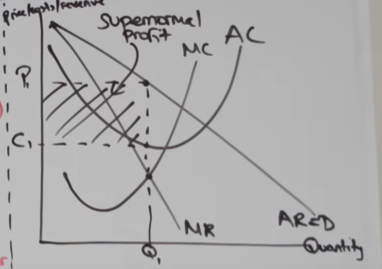
efficiencies in a monopoly
not allocatively efficient as they are not producing at AR/P = MC
misallocation of recourses, exploiting consumers with high prices, restricted output an low consumer surplus, choice and quality also low as there are no competitors
not productively efficient as the monopoly is not producing where MC = AC
monopolist could also be too big casing diseconomies of sale, producing on the rising part of AC
not X efficient as as they are producing above their AC curve allowing for waste because there is no competitive drive
statically inefficient
potential for dynamic efficiency as there are long run supernormal profits being made in the long term as there are high barriers to entry and imperfect information keeping other firms out the market
profits reinvested in innovation and new technology, capital investment
benefits consumers
monopoly deadweight welfare loss
PM, QM is taken from the monopolies profit maximising point
PC, QC is a competitive firms quantity taken from the allocatively efficient point of production
monopoly reduces consumer surplus from ABC TO A
monopoly increases producer surplus from DE to DB
monopoly reduces society surplus (producer + consumer surplus) from ABCDE TO ABD
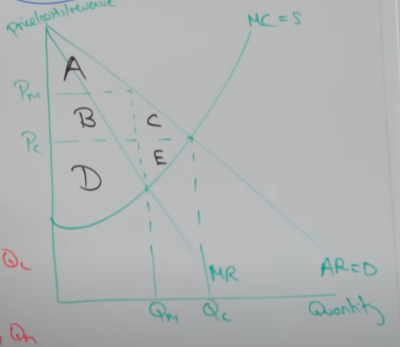
advantages of monopolies
dynamic efficiency
reinvesting profit can result in better quality for consumers and possibly lower prices
greater EOS
exploit greater EOS than competitive markets due to their size
natural monopoly
a regulated natural monopoly can give society desirable outcomes and stop the wasteful duplication of resources
cross substitution
use supernormal profits to subsidies a loss making good they are producing, socially desirable
disadvantages of monopolies
allocative inefficiency, price is higher than marginal cost meaning consumers are exploited, paying more than what it costs to produce, lower consumer surplus
deadweight welfare loss of consumer surplus show on diagram
productive inefficiency
voluntarily forgoes EOS by not operating where MC = AC, lower part of AC curve
X inefficiency
allow waste in the production process due to a lack of competitive drive, producing beyond the AC curve
can cause inequalities
especially in necessity markets
as prices are higher at MR = MC
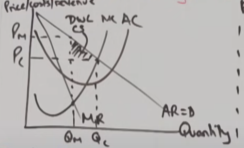
monopoly evaluation
supernormal profit may not be reinvested - dynamic inefficiency
profits may be given to shareholders as dividends, or pay debts
EOS or DOS depending on size of the firm
regulated monopoly can reduce inefficiencies
price discrimination can exaggerate monopoly inefficiencies and inequalities
competition threat can reduce inefficiencies
type of goods or service
if good is a necessity it is bad however is the monopoly is producing a luxury good it may not be as harmful
price discrimination
where a firm charges different prices to different consumers for an identical good/service with no differences in cost of production
conditions for price discrimination
price making ability - need monopoly power
information to sperate the market into different PEDs
prevent re-sale, stop people buying low and selling high (market seepage)
1st degree price discrimination
consumers are charged the exact price they are willing to pay for a good/service
eroding all consumer surplus and turning it into monopoly profit
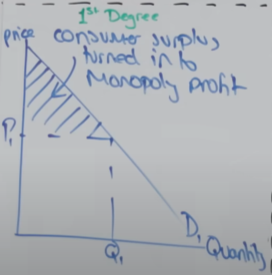
2nd degree price discrimination
firms with fixed capacity
last minute, firms lower their prices in order to fill capacity and contribute towards fixed costs
airline company
MC curve is horizontal (constant) up to their capacity where it becomes vertical where they cant produce anything more
firm produces at MR = MC (Q1) maximising profits
results in excess capacity from Q1 to Qcap
firm lowers price to fill capacity to bring in revenue to contribute towards fixed costs (P2), all capacity is filled
consumers that buy last minute tickets gain consumer surplus
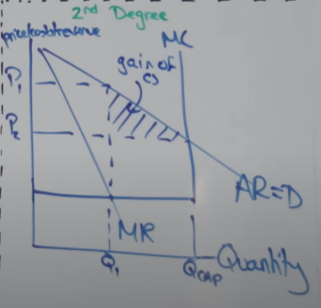
3rd degree price discimination
occurs when a firm can segment the market into different PEDs
based on time, age, geography or income differences and will charge different prices to different groups
rail company
inelastic, people who need to get to work
elastic, leisure travellers, off peek times
MC is constant as it costs the same to fill 1 more seat on the train
higher prices in an inelastic demand, exploiting consumers
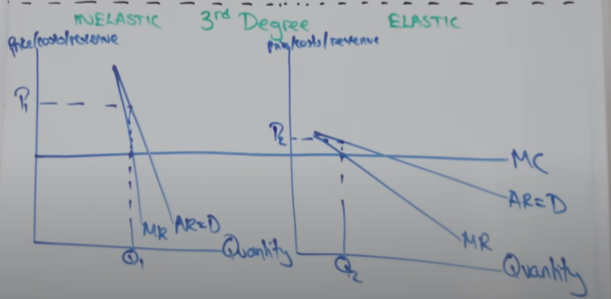
advantages of price discrimination
greater profits can result in dynamic efficiency
higher quantity in 2nd and 3rd degree allows for greater EOS - lower prices
some consumers benefit for price discrimination
cross subsidisation - profits may be used to subsidies loss making goods elsewhere in the business allowing them to still be provided to consumers
disadvantages of price discrimination
allocative inefficiency
prices higher than MC, exploiting consumers
inequalities
widens income inequality
anti-competitive pricing
lower prices diving out competitors, pure monopoly power
characteristics of natural monopolies
high fixed/sunk costs
high potential for EOS
rational for 1 firm to supply the entire market
to avoid the wasteful duplication of resources and non exploitation of full EOS - allocative and productive inefficiency
competition is undesirable
examples - water, gas distribution
natural monopoly graph
producing at the profit maximising point of MR = MC, Q1, P1 generates supernormal profit as P1 is above LRAC
high prices and low quantitates
bad outcomes for essential services such as water (excluding poorer consumers), compared to the allocatively efficient point (P = MC)
charging these excessively high prices is deemed not good enough by regulators
with regulation at the allocatively efficient point, means a reduction in price and costs to P2, C2
here there is subnormal profit being made as costs are now high than prices
this incentivises to the natural monopoly to leave the industry, and so private natural monopolies are often subsidised
subsidy given is equivalent to to the loss per unit (a, b per unit) allowing them to make normal profit
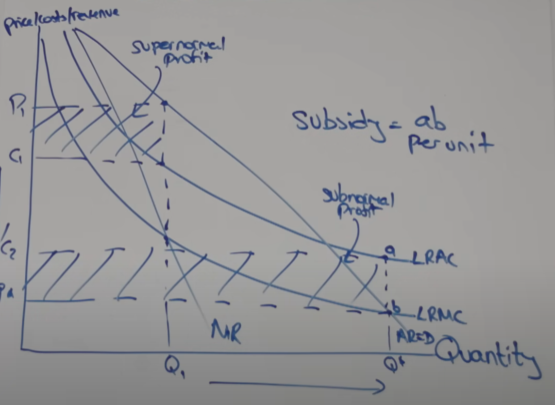
natural monopoly evauation
as long as the market is dominated by 1 firm and there is regulation, there is allocative (P=MC) and productive efficiency (lowest point on AC)
better outcome that a competitive market
if regulated, there will be no more supernormal profit so dynamic efficiency isn’t possible
characteristics of a contestable market
low barriers to entry/exit
large pool of potential entrants
good information
incumbent firms (already in the market) subject to hit and run competition
firms quickly enter the market, take supernormal profit then leave again before incumbent firms can lower profit margins
how has technology increased barriers to entry
decreased barriers to entry
lower sunk costs, easier to achieve EOS, easier to advertise
increased pool of potential applicants
easier to innovate
cheaper ways of producing things
improved information
contestability in a monopoly
a monopoly prices at PM, QM, the profit maximising point, making supernormal profit
if the market is contestable the monopoly would move to PC, QC where AR = AC the limit price, making normal profit, break even point, removing the incentive for firms to enter the market
this lowers the price and increases the quantity - competitive outcome
limits threat
then price can be increased when the threat goes away

advantages of contestable markets
movements towards competitive outcomes give similar benefits to a competitive markets
allocative efficiency
lower price, higher quality, more consumer surplus, better choice
productive efficiency
better exploitation of EOS, lower costs, lower prices for consumers
x efficiency
minimising waste, lower costs, lower prices for consumers
job creation because of higher quantity - labour is in derived demand
disadvantages of contestable markets
lack of dynamic efficiency
lower profit margins, less progress over time
however if new firms come into the market with innovative ideas, that is the benefit of dynamic efficiency
cost cutting in dangerous areas
safety, environment impacted
creative destruction
new innovation destroys existing firms - job losses
however overall if market is greater workers who have lost jobs can move to newer firms
anti-competitive strategies
overtime if businesses use anti-competitive strategies like limit or predatory pricing, flooding the market or mergers, contestability will not last overtime
results in static inefficiencies in long run
contestable markets evauation
length of contestability
if new firms can patent ideas or use anti-competitive strategies, the market wont be contestable overtime
role of technology
patents
makes it easier for firms to price discriminate as they have access to more information - not statically efficient
regulation
minimise cost cutting in dangerous areas and anti-competitive strategies
negates other disadvantages
dynamic efficiency
competitive markets
a market structure characterised by many buyers and sellers, where no single buyer or seller has the power to influence the market price
advantages of competitive markets
allocative efficiency
P=MC consumers pay what it costs top produce, lower prices, higher consumer surplus, resources will be following consumer demand, more choice
productive efficiency
minimising average costs, exploiting EOS, passing on lower costs to consumer in the form of lower prices
x efficient
minimising waste and producing on the AC curve resulting in lower prices for the consumer
job creation
labour is in derived demand - link to employment and living standards
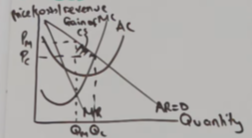
disadvantages of competitive markets
lack of dynamic efficiency
only normal profit left so there is no room for reinvestment, no progress over time, loss for consumers
lack of EOS
even if firms are productively efficient, they may not have the potential of EOS as they have lower output
cost cutting in dangerous areas
environment, health and safety, wages
creative destruction
when new firms enter the market, their creativity/innovation can destroy incumbent firms - unemployment, worse living standards
however those workers may be able to move to other new firms in the industry
competitive markets evaluation
still may have enough profits for a small investment, reinvestment may be a part of competition in these markets - dynamic efficiency
level of EOS
where is cost cutting taking place
role for regulation
static vs dynamic efficiency
static efficiency (lower prices and higher quantity) is more desirable in some markets where as in some markets dynamic efficiency is preferred as consumers are willing to pay for for innovation